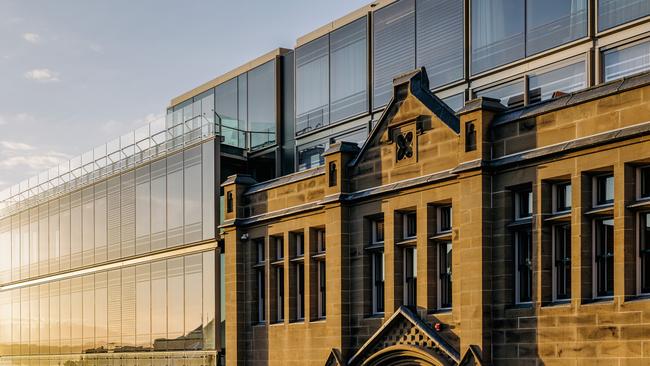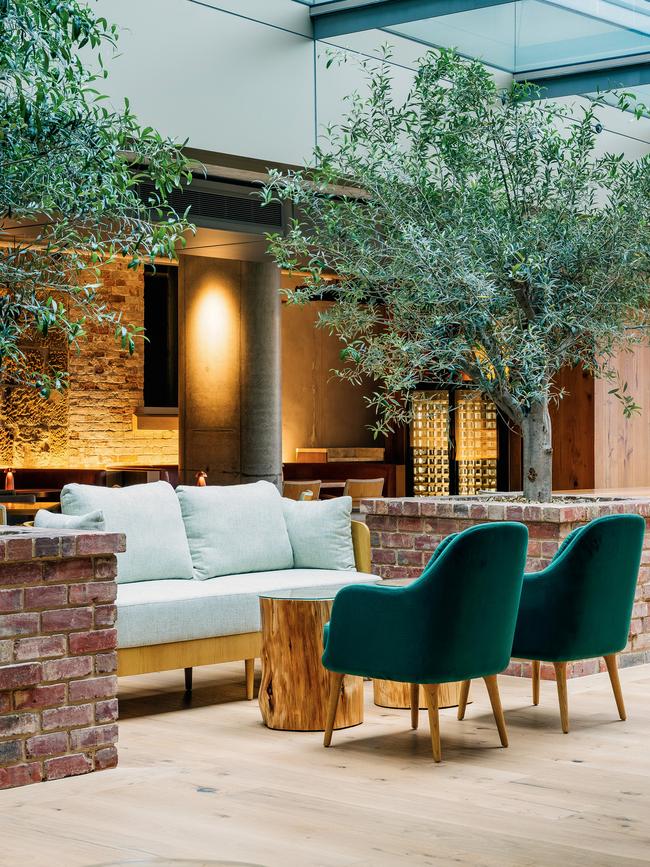The Tasman Hobart: Inside Tasmania’s new golden star
In an exclusive first-look at The Tasman, Hobart’s dashing new hotel, Travel + Luxury salutes its canny mix of historical preservation, artisanal curation and culinary credentials.
It may be the swankiest accommodation to open in Hobart in years, but The Tasman has, like so much of Van Diemen’s Land, a story behind the story. It’s on the site of the one-time St Mary’s Hospital, started in the 1840s by Dr Edward Samuel Pickard Bedford, whose stated aim was that it should service the “labouring classes”. The workers originally had a red-brick building, but later they constructed a magnificent sandstone edifice, complete with a crenellated parapet over the second storey, for Dr Bedford and his medicos. Whether or not the labourers were the real beneficiaries of St Mary’s private hospital is a little clouded in the mists of time admittedly.
One thing’s for sure: a medical facility for working- class people is a far cry from the extremely posh Marriott-run Luxury Collection group hotel that exists on the site today. The Tasman, a brand-new 152-room, U-shaped hotel, which takes up almost an entire half of the city block, is a nod to the best of today rather than the labouring class of yesteryear. You can book a suite here, down near the waterfront behind Parliament House, with a bath crafted from more than a hundred individual pieces of blackwood, made using boatbuilding techniques perfected by artisan Emanuel “Manny” Oppliger. You could sup a well-made Martini in the Deco bar with its lovely diptych of etchings by local artist Mandy Renard. Or head out to the city or Salamanca, both right outside the doors, to find galleries, museums, whisky bars and a whole lot more than a city this size normally boasts.

The Tasman is almost three hotels in one. In the old sandstone hospital, rooms are high ceilinged, airy and spacious, with a more Downton Abbey theme. They’re graced with restored Georgian fireplaces and their original windows. In the converted Art Deco former council building from 1937 the rooms hint at the architecture that made the era famous, with rounded bedside tables, curved button stools and chrome flourishes. A bit more Miss Fisher than Downton. The modern glass-wrapped Pavilion building, meanwhile, opens up the hotel to its spectactular waterfront location and infuses the overall look with a modernist sensibility.
The design across the board, by Sydney-based architects Francis-Jones Morehen Thorp (FJMT), is sensitive to the history of both heritage buildings. Earlier restorations by the group include The Tasmanian Museum and Art Gallery, where they expanded the exhibition space and retooled its outdoor areas. The Tasman’s guest rooms were finessed by Sydney interior designer Joseph Pang. If the dramatic corner room with a curved window overlooking Hobart’s small but bustling downtown isn’t your thing, there are more modest, yet lavishly appointed standard rooms. A merging of eras means the hotel is a wonderful labyrinth with varying floor heights, which must’ve given the architects a headache, but make it infinitely more fun to explore. It’s easy to become disorientated if you wander the corridors. At each turn a new look, a new nook.

Heritage rules mean there’s plenty of sandstone to see, too. Plenty of little treasures to find. In fact, tucked on one side, the former coal cellar is home to liquid gold: barrels of moonshine maturing in oak. Closer inspection reveals it to be apple brandy from Charles Oates and whisky from Bill Lark, the godfather of the Tasmanian whisky scene. Lark is the reason Tasmania has more whisky distilleries than Ireland, only a couple of decades after stills became legal. The old building doesn’t have ghosts, but it does have charm. After the place was a hospital, it became government offices, but there’s little of the bureaucracy about it today. It’s more glam than glum. More time-off-work than paperwork. More red-letter day than red tape.
St Mary’s didn’t survive the transformations of the city over the years. The site was used for the Lands and Survey department for much of its life. But the original building’s red bricks are used everywhere, adding to a sense of time, and the bar is named in honour of the erstwhile hospital designed for commoners. In fact, under head barman Ronán Kavanagh, the bar is still hoping to attract everyday Hobartians – locals who know a classic cocktail bar when they see it, and appreciate a bartender who remembers what they like to drink and where they like to sit. A bar with table service, no less. To make it more friendly to passing trade, both Mary Mary and the hotel’s flagship restaurant Peppina are easily accessed without having to go through the hotel itself. It’s a sign they are designed as much with locals in mind as the hotel guests. Kavanagh is reimagining signature libations by thinking of how the early 1900s drinks would be have been designed if they originated in Tasmania. Would they have had port? Pepperberry? Leatherwood honey and white rye?

While Mary Mary has a dark, moody feel from the leather, stone and recycled parquetry flooring, Peppina, with its glass ceiling and pale-blue upholstery, is wide open. The yin to Mary Mary’s yang. Marriott’s Luxury Collection philosophy, allowing local flavour in their bars, rooms and sourcing, flows through to the dining room.
This is local chef Massimo Mele’s baby, the menu driven by him, and his Italian heritage. The name Peppina is in honour of his grandma, whose side he used to stand next to as she cooked the produce from her farm near Naples. Peppina was her nickname. While Mele was born into a Hobart restaurant family, and worked his first café jobs at the Salamanca waterfront metres from here, he spent his formative years in Italy at his nonna’s apron strings.
As culinary director (meaning he won’t actually be rattling the pans most nights, but will oversee the entire menu from farm to plate) it’s Mele’s sourcing of Tassie fare that promises to make this not just a hotel restaurant of note, but a diner of note full stop. His personal attention is why the menu is so produce- focused, the dishes chosen because the ingredients justify their place, culturally, geographically, and gastronomically, often sourced directly from the farm. The chefs have visited places such as Tongola in the southeast to see the goat’s being milked, before watching the milk being turned into lovely cheese. They’ve visited organic gardening guru Tony Scherer to see what vegetables can be grown specifically for Peppina. In fact, Mele’s own garden is also a source of produce for the diner.

In the three years since the hotel was first mooted to Mele, he’s been out finding the best of Tassie. So Peppina has an oyster bar where you can indulge in a tasting comparison of different regions. Vegetables and meats may see the kiss of the wood oven, or the asado grill. On a daily-evolving menu, there could be marinated octopus with Tassie’s famed pink-eye potatoes and watercress. Or cavatelli (little shell- shaped pasta) with broccoli, broad beans and salted ricotta. Or perhaps char-grilled lamb rump with fennel, mint and olive pesto.
The dining room itself is airy and light, a mix of booths and smart wooden tables, along with bar stools and a large communal table. It’s a please-all space, perfect for a lone diner tucking into a simple plate of gnocchi with pork sausage, porcini and broccoli raab, paired with a glass of cool-climate pinot noir after work, or to push the boat out with a crowd and raid the not-insubstantial cellar. A place that bends to your moods, and one tailored to locals and visitors alike.
A favourite space in the hotel is the private dining and tasting room in the old building that once housed the printing presses for the surveyors’ department. Running the length of the sandstone-lined space is a single 18-seater table by local designer Scott van Tuil. The feel is at once intimate and lush, old and yet new. Something gifted by history, revamped for a new era.
The Tasman feels truly Tasmanian, even as it opens, despite its international standing. It has echoes of history. It has fine modern art. It has a strong predilection for great food and great drinks, while carrying an easy confidence and charm about where it sits and who it caters to. For those looking for quality, for the good things – from the linen to the location, the pillows to the paccheri pasta – The Tasman offers something for everyone, from lawyers to labourers.
